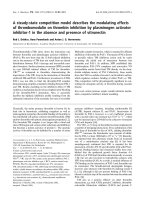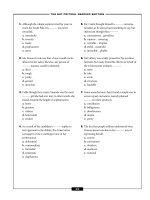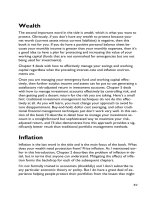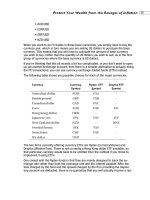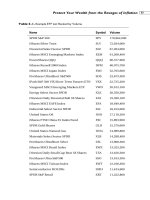Slides 11 1 determine the purpose and motivation for leader
Bạn đang xem bản rút gọn của tài liệu. Xem và tải ngay bản đầy đủ của tài liệu tại đây (1.72 MB, 35 trang )
Determine the Purpose and
Motivation for Leadership Driven
Cost Control Processes
© Dale R. Geiger 2011
1
Being Out of Control Isn’t Good
© Dale R. Geiger 2011
2
Terminal Learning Objective
• Task: Determine the Purpose and Motivation for
Leadership Driven Cost Control Processes
• Condition: You are training to become an ACE with
access to ICAM course handouts, readings, and
spreadsheet tools and awareness of Operational
Environment (OE)/Contemporary Operational
Environment (COE) variables and actors.
• Standard: with at least 80% accuracy
• Describe the history of rule-driven cost control processes
• Determine the difference between budget management
and cost management
• Identify benefits of Cost Managed Organizations
© Dale R. Geiger 2011
3
Program of Instruction
Overview
Week One
Week Two
Week Three
Understanding Cost
Learning the Process
Applying the Process
Accounting Basics
Cost Relationships
Cost Tradeoffs
Cost Projection
Cost Explanation
Cost Benefit Analysis
CBA Examples
Cost Management
After Action Review
Cost Management Cases
© Dale R. Geiger 2011
4
Program of Instruction
Overview
Week Three
Applying the Process
5
Applying the Process
• We have so far talked about tools
• Measurement, analysis, CBA, planning, AAR process,
continuous improvement
• The goal of Week Three is to give you greater
practical insight into applying them
• Using real examples of successful government cost
management and control cases
• Extrapolating to Army opportunities
• While building sensitivity to change management
© Dale R. Geiger 2011
6
There is a Long History of
Trying to Improve Management
Waste, Fraud and Abuse
Anti-Deficiency Act
Budgetary Control
GPRA, CFO Act
Enhanced Reporting
Presidential Initiatives
Performance Measurement
Limited Fiscal Resources
Performance Management
© Dale R. Geiger 2011
7
Winning the Cost War Theses
• The Cost War is the struggle to accomplish the mission in
an environment of constrained fiscal resources
• Combatant Commanders are inherently cost (casualty)
conscious
• Command and Control is a cost management paradigm
• After Action Review is a continuous improvement process
• Continuous improvement is always possible by everyone
• Cost measurement is an intelligence input to Cost Warriors
• Adapting proven Command and Control technique offers
an aggressive approach to Winning the Cost War
© Dale R. Geiger 2011
8
Status Quo: Highly Developed
Rule Driven Processes
• Rule-driven management
• Provides many barriers (and excuses) that
diminish creativity
• Results in a compliance centered behavior
(“My guess is that a third of the defense budget goes into the friction
of following bad regulations – doing work that doesn’t need to be
done.”
Bob Stone former DASD Installations, Reinventing Government)
• Rules work best when they provide
boundaries rather than prescriptions to
behavior
© Dale R. Geiger 2011
9
Bob Stone Anecdote
• While visiting Ft Bragg on a hot summer day he
asked a young soldier how the restricted thermostat
was being received . . .
• “No problem sir – all we have to do is leave a lamp
light bulb burning next to the thermostat and we can
drive down the temperature very nicely”
© Dale R. Geiger 2011
10
Leadership Driven Management
• Recognizes that there is always a better way to
do things
• Capitalizes on the accountable creativity and
ingenuity of the workforce
• Motivates excellence rather than compliance
© Dale R. Geiger 2011
11
Contrasting Managerial Dimensions
Goals
Financial
Accountability
Rule Driven
Leadership Driven
Follow the Rules,
Obey the Law
Increase Mission
Effectiveness
Don’t Overspend
the Budget
Achieve Challenging,
but Flexible Plans
Motivation
Negative – Avoid
Punishment
Positive – Achieve
Recognition
Information
Systems
Comply Reporting
Requirements
Inform Management –
Internal Reporting
© Dale R. Geiger 2011
12
Learning Check
• What three acts of Congress targeted
improved government financial management?
• What constitutes success under a rule-driven
management approach?
© Dale R. Geiger 2011
13
Group 1-6 Assignment
• Design a set of rules, monitoring, and
enforcement measures to:
1.
2.
3.
4.
5.
6.
Eliminate unnecessary car trips
Ensure good food consumption
Eliminate excessive phone minutes
Promote good TV watching and reading
Ensure proper amount of exercise
Ensure good night’s sleep
© Dale R. Geiger 2011
14
The Increased Importance of
Leadership Driven Management
• Leadership driven management means
making the best of what you've got
• Leadership driven management is not
needed or important if resources are
plentiful
• Limited fiscal resources make leadership
driven management critically important
© Dale R. Geiger 2011
15
Leadership’s Roles in the Leadership
Driven Management Process
• Publish clear commander’s intent
• Enlist, train, motivate, and lead a cost conscious,
aggressive management team
• Personally lead the cost after action review
• Identify and reward the best performers
• Give them more important cost management
missions
• Identify those unable or unwilling to engage and
motivate or replace
© Dale R. Geiger 2011
16
Cost Planning Comparison
to Budgeting
• Budgeting provides resources
• Infrequently and based on strategic priorities
and user defined needs
• With statutory requirements to spend
• Cost planning helps manage resources
• Continuously and based on tactical
opportunities
• With cost warrior mandate to save
© Dale R. Geiger 2011
17
Budget Management is
Not Cost Management
• Takes too long to get feedback cycle
• Eighteen months to see results
• Results don’t stimulate learning
• Organizations spend 99.9%
• Creates spending entitlement and mandate
• Even when reduction is possible and needed
• Discourages cost reduction
• Creates “Why save if I don’t get to keep it”
culture
© Dale R. Geiger 2011
18
Budget Execution Forces Impacting
Mission Effectiveness
This is the
budget
Where will we
be at the end
of the year???
$
Performance
© Dale R. Geiger 2011
19
Budget Execution Forces Impacting
Mission Effectiveness
Budget Controls
Anti-Deficiency Act
We are
restricted from
spending more
$
Performance
© Dale R. Geiger 2011
20
Budget Execution Forces Impacting
Mission Effectiveness
Budget Controls
Anti-Deficiency Act
We are
reluctant to
spend less
$
Organizational Pressures
Performance
© Dale R. Geiger 2011
21
Budget Execution Forces Impacting
Mission Effectiveness
Budget Controls
Anti-Deficiency Act
$
There are lots
of things
dragging down
performance
Drift
Organizational Pressures
Performance
© Dale R. Geiger 2011
22
Budget Execution Forces Impacting
Mission Effectiveness
Budget Controls
Anti-Deficiency Act
$
Drift
Leadership
Only Cost
Management &
Control can
offset drift
and/or improve
performance
Organizational Pressures
Performance
© Dale R. Geiger 2011
23
New Management Approaches
are Needed
• The budget process
• Creates entitlements
• De-motivates continuous improvement
• Spends enormous resources defining,
defending, and ultimately in denying “needs”
• “Needs based” funding culture must
change to one of “needs reduction”
© Dale R. Geiger 2011
24
Imagine!
• Paying your subordinates on basis of their self
defined needs
• How would their motivations change?
• How much effort would they spend arguing
needs?
• Why would they ever reduce needs?
• Why would they ever produce work?
• Who would want to change?
© Dale R. Geiger 2011
25

